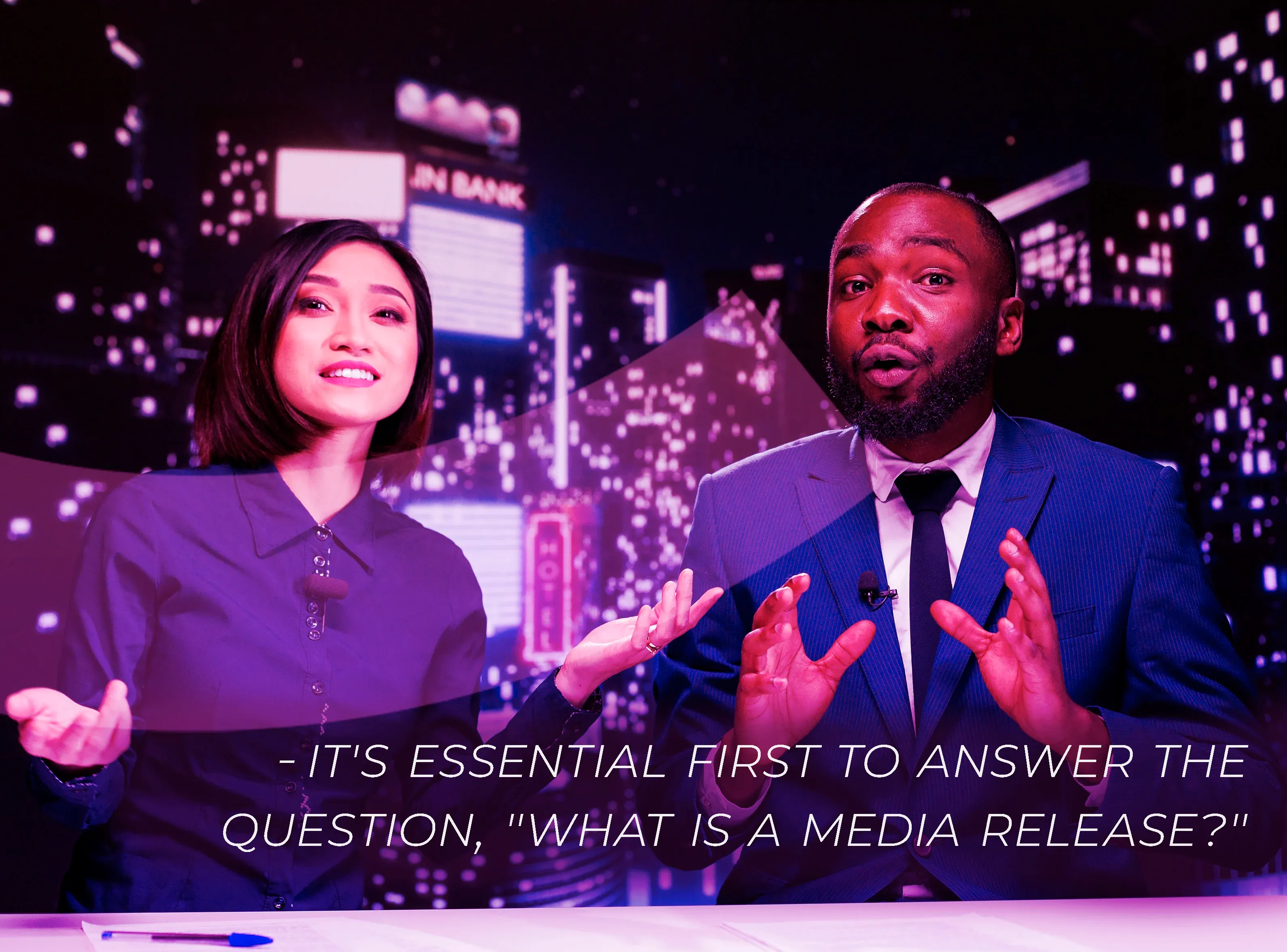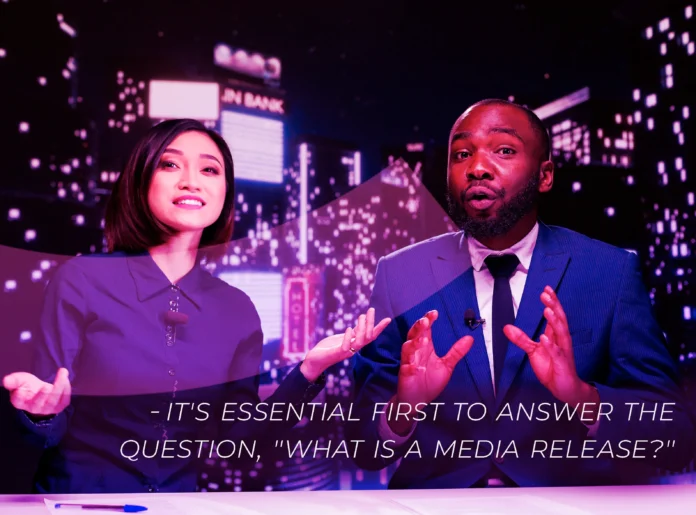As we find new ways to share information and news, the media release is still an important tool for PR professionals. It bridges the gap between traditional media outlets and digital channels, ensuring that messages are disseminated widely and effectively.
By following established PR practices, organizations can create messages that attract journalists and connect with the public.

Defining a Media Release
To comprehend the importance of media releases, it’s essential first to answer the question, “what is a media release?” A media release is a formal announcement distributed to the media, intended to convey information about an organization’s significant news or events. This document is crafted in a manner to ensure clarity, accuracy, and newsworthiness, aiming to capture the attention of journalists and news outlets. The strategic nature of media releases allows organizations to control the flow of information, ensuring that their messages are presented accurately and compellingly to the media.
Media releases serve as an official record of an organization’s announcements, providing a reliable source of information for journalists. By presenting information in a clear and concise format, media releases facilitate the reporting process, making it easier for journalists to cover stories accurately. This symbiotic relationship between organizations and the media underscores the importance of media releases in the PR toolkit. By understanding what constitutes a media release, organizations can harness its power to effectively communicate with their target audiences.
What is a News Release?
The term “news release” is often used synonymously with a media release. However, it emphasizes the newsworthy aspect of the content. A news release is specifically designed to inform the media about events, product launches, or any organizational developments deemed newsworthy. The objective is to entice journalists to cover the story, thereby amplifying the organization’s message to a broader audience. This focus on newsworthiness ensures that the content is relevant and timely, increasing the likelihood of media coverage.
In addition to its newsworthiness, a news release serves as a strategic tool for shaping public perception. By highlighting key developments and milestones, organizations can reinforce their position in the marketplace and enhance their reputation. News releases also provide an opportunity to address potential concerns or misconceptions, fostering a positive image. By carefully crafting a news release, organizations can ensure that their messages align with their strategic goals and resonate with their intended audience.
Press Release Definition
A press release, similar to a news release, serves the dual purpose of informing the public and engaging the media. The press release definition encapsulates a written communication that reports specific, but brief, information about an event or circumstance. It is typically tied to a particular time frame or event, such as a product launch or a significant organizational milestone. The structured format of a press release ensures that key information is presented in a logical and coherent manner, facilitating media coverage.
Press releases are also valuable tools for enhancing an organization’s credibility and authority. By providing factual and timely information, organizations can establish themselves as reliable sources of news and insights. This credibility can translate into increased media interest and coverage, further amplifying the organization’s message. The press release’s role in shaping public perception and building trust underscores its importance in a comprehensive PR strategy.
Purpose of Media Releases
The primary purpose of media releases is to inform and engage. They are not merely a tool for disseminating information; they are a strategic component of a comprehensive PR strategy developed to help brands connect with their audiences.
By crafting media releases that are both informative and engaging, organizations can effectively communicate their messages to a wide audience. This dual purpose underscores the importance of media releases in achieving organizational goals and fostering positive relationships with stakeholders.
Informing the Public and Media
Media releases are essential for informing both the public and the media about noteworthy developments within an organization. By presenting information in a newsworthy format, organizations can control the narrative and ensure accurate dissemination of information. This control is crucial in maintaining a consistent and positive image in the media, as it allows organizations to highlight their achievements and address any potential issues proactively.
Beyond merely informing, media releases play a critical role in shaping public perception. By strategically framing their messages, organizations can influence how their announcements are perceived by both the media and the public. This influence is particularly important in competitive industries, where maintaining a positive reputation can be a key differentiator. By understanding the power of media releases in shaping perception, organizations can leverage them to build and sustain their brand image.
Engaging with Stakeholders
Beyond informing, media releases serve as a means of engaging with stakeholders. They provide an opportunity for organizations to communicate directly with their audience, whether it be customers, investors, or the general public. This engagement fosters transparency and trust, key components in building long-term relationships. By addressing stakeholder interests and concerns in media releases, organizations can enhance their credibility and foster a sense of community.
Media releases also serve as a platform for organizations to showcase their values and commitments.
By highlighting initiatives and achievements that align with stakeholder interests, organizations can strengthen their relationships and build loyalty. This alignment with stakeholder values is increasingly important in today’s socially conscious marketplace, where consumers and investors alike seek to support organizations that reflect their own values. By engaging stakeholders through media releases, organizations can reinforce their commitment to these values and foster a positive, lasting impact.
Enhancing Brand Visibility
A well-crafted media release can significantly enhance brand visibility. By capturing the attention of media outlets, organizations can amplify their message and reach a wider audience. This increased visibility can lead to greater brand recognition and credibility in the marketplace. By strategically targeting media outlets that align with their brand, organizations can ensure that their messages reach the most relevant audiences, maximizing their impact.
In addition to traditional media outlets, media releases can be leveraged across digital platforms to further enhance visibility. By sharing releases on social media and other digital channels, organizations can reach a broader audience and engage directly with consumers. This digital amplification can drive further interest and engagement, creating a ripple effect that extends the reach of the original media release. By understanding the potential of media releases to enhance visibility, organizations can harness their power to achieve their PR objectives.
Differences Between Media Releases, Press Releases, and News Releases
While the terms media release, press release, and news release are often used interchangeably, subtle differences exist between them. Understanding these differences can help organizations tailor their communication strategies to their specific needs and objectives.
Media Release vs. Press Release
The term “media release” is broader in scope, encompassing all communications intended for the media, including press releases. A “press release” specifically targets journalists and is often geared towards print media. The distinction lies primarily in the target audience and the medium through which the information is disseminated. By recognizing these differences, organizations can ensure that their messages are accurately tailored to their intended recipients.
Despite these distinctions, both media releases and press releases share common goals: to inform, engage, and influence. By crafting messages that resonate with their respective audiences, organizations can effectively leverage these tools to achieve their communication objectives. The choice between a media release and a press release ultimately depends on the organization’s goals and the nature of the information being shared.
News Release vs. Press Release
The difference between the news and press release, is that the news release emphasizes the newsworthiness of the content, focusing on events or developments that are timely and relevant. A press release, on the other hand, may cover a broader range of topics, not all of which are necessarily newsworthy. The choice between the two depends on the organization’s goals and the nature of the information being shared. By understanding these nuances, organizations can ensure that their messages are effectively communicated and received.
While both news releases and press releases are valuable tools in a PR strategy, their effectiveness hinges on their alignment with organizational objectives. By carefully considering the purpose and audience of each release, organizations can maximize their impact and achieve their desired outcomes. Understanding the differences between these types of releases allows organizations to strategically deploy them in a way that aligns with their communication goals.
Practical Applications of Media Releases in PR
In today’s dynamic PR landscape, media releases play a crucial role in various strategic initiatives. By understanding the practical applications of media releases, organizations can harness their power to achieve their PR objectives and drive meaningful results.
Product Launches and Announcements
Media releases are instrumental in announcing product launches and other significant organizational developments. They provide a platform for organizations to share detailed information about new offerings, thereby generating interest and excitement among consumers and the media. By highlighting the unique features and benefits of new products, media releases can drive consumer interest and stimulate demand.
In addition to generating excitement, media releases can also help establish credibility and authority in the marketplace. By showcasing their expertise and innovation, organizations can position themselves as leaders in their industry, attracting media attention and consumer interest. This positioning can lead to increased sales and market share, underscoring the importance of media releases in product launch strategies.
Crisis Management
In times of crisis, media releases serve as a vital tool for managing public perception. By providing timely and accurate information, organizations can mitigate negative impacts and maintain control over the narrative. This proactive approach is essential in preserving brand reputation and trust. By addressing concerns and providing reassurance, media releases can help organizations navigate challenging situations and emerge stronger.
Effective crisis management requires a strategic and measured approach. By crafting media releases that address key issues and provide clear guidance, organizations can demonstrate their commitment to transparency and accountability. This commitment can enhance stakeholder trust and confidence, fostering resilience and recovery. In the face of adversity, media releases serve as a powerful tool for maintaining stability and protecting an organization’s reputation.
Event Promotion
For events, media releases act as a promotional tool, highlighting key details and enticing media coverage. By strategically timing the release, organizations can maximize exposure and attendance, ensuring the event’s success. By showcasing the significance and appeal of the event, media releases can drive interest and participation, creating a memorable experience for attendees.
Media releases also provide an opportunity to showcase an organization’s values and culture. By highlighting the purpose and impact of the event, organizations can reinforce their commitment to their mission and engage stakeholders. This engagement can lead to stronger relationships and greater support, enhancing the overall impact of the event. By leveraging media releases for event promotion, organizations can achieve their objectives and create lasting value.
Crafting an Effective Media Release
Creating an effective media release requires careful consideration and strategic planning. The following elements are essential for success:
Clear and Concise Writing
The writing style should be clear, concise, and free of jargon. The goal is to convey information quickly and effectively, capturing the reader’s attention from the outset. By using straightforward language and focusing on key messages, organizations can ensure that their media releases are easily understood and impactful.
In addition to clarity, the tone and style of the writing should align with the organization’s brand and values. By maintaining a consistent voice, organizations can reinforce their identity and strengthen their connection with their audience. This consistency is key to building trust and credibility, enhancing the overall effectiveness of the media release.
Compelling Headlines
A compelling headline is crucial for attracting media attention. It should encapsulate the essence of the release, enticing journalists to read further. By crafting headlines that are both informative and intriguing, organizations can capture the interest of their target audience and increase the likelihood of media coverage.
The headline should also align with the overall message and tone of the release. By ensuring consistency and coherence, organizations can reinforce their key messages and enhance the impact of the media release. A well-crafted headline can serve as a powerful tool for drawing attention and driving engagement, underscoring its importance in the media release process.
Relevant and Newsworthy Content
The content must be relevant and newsworthy, providing value to the media and the intended audience. It should address the “who, what, when, where, why, and how” of the story, ensuring comprehensive coverage. By focusing on the most important and impactful aspects of the announcement, organizations can ensure that their media releases resonate with their audience.
In addition to relevance, the content should be authentic and transparent. By providing accurate and truthful information, organizations can build trust and credibility with their audience. This authenticity is key to fostering positive relationships and enhancing the overall effectiveness of the media release. By prioritizing relevance and authenticity, organizations can craft media releases that drive meaningful results.
Strategic Distribution
Strategic distribution is key to maximizing the impact of a media release. By targeting the right media outlets and journalists, organizations can ensure their message reaches the desired audience. By considering factors such as audience demographics and media reach, organizations can tailor their distribution strategy to achieve their communication goals.
In addition to traditional media outlets, digital channels offer additional opportunities for distribution. By leveraging social media, email, and other digital platforms, organizations can extend the reach of their media releases and engage directly with their audience. This multi-channel approach can enhance visibility and drive further engagement, amplifying the impact of the media release. By understanding the importance of strategic distribution, organizations can maximize the effectiveness of their media releases and achieve their PR objectives.
Conclusion
In the ever-evolving world of public relations, media releases remain a vital tool for organizations seeking to communicate effectively with the media and the public. By understanding the nuances of media releases and leveraging them strategically, PR professionals can enhance brand visibility, engage stakeholders, and navigate the complexities of the modern communications landscape. As the industry continues to evolve, the importance of media releases in PR will undoubtedly endure, serving as a testament to the enduring principles of effective communication.
As organizations navigate the challenges of the digital age, media releases offer a reliable and effective means of sharing their messages with the world. By adhering to established PR practices and embracing new technologies, organizations can craft media releases that resonate with their audience and drive meaningful results. The enduring value of media releases underscores their importance in a comprehensive PR strategy, highlighting the power of strategic communication in building and maintaining an organization’s reputation.
Contact us today to learn more about how we can support your press release distribution, media targeting, pitching, and monitoring efforts!














